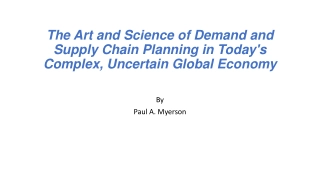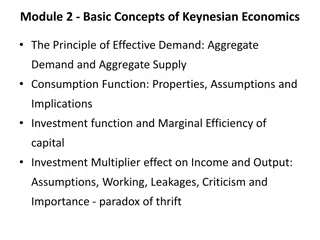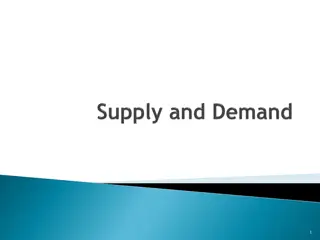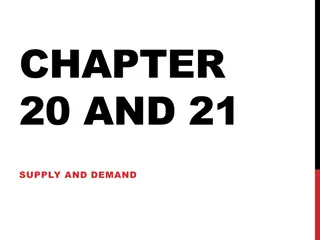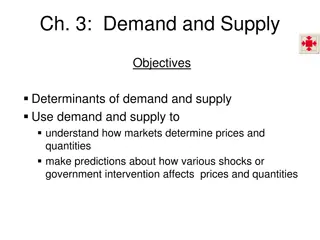
Supply, Demand, and Market Equilibrium
Explore the dynamics of supply and demand, how prices are set, and the concept of market equilibrium. Learn about demand schedules, utility in product buying decisions, and the law of demand. Discover why the demand curve slopes downward and how diminishing marginal utility influences consumption choices.
Download Presentation

Please find below an Image/Link to download the presentation.
The content on the website is provided AS IS for your information and personal use only. It may not be sold, licensed, or shared on other websites without obtaining consent from the author. If you encounter any issues during the download, it is possible that the publisher has removed the file from their server.
You are allowed to download the files provided on this website for personal or commercial use, subject to the condition that they are used lawfully. All files are the property of their respective owners.
The content on the website is provided AS IS for your information and personal use only. It may not be sold, licensed, or shared on other websites without obtaining consent from the author.
E N D
Presentation Transcript
Supply, Demand, and Market Equilibrium
The forces of supply and demand work together to set prices. Demand is the desire, willingness, and ability to buy a good or service. Supply can refer to one individual consumer or to the total demand of all consumers in the market (market demand).
A demand schedule is a table that lists the various quantities of a product or service that someone is willing to buy over a range of possible prices. Price per Widget($) Quantity Demandedof Widget perday 2 4 6 8 10 $5 $4 $3 $2 $1
A demand schedule can be shown as points on agraph. The graph lists priceson the vertical axis and quantities demandedon the horizontal axis. Each point on the graph shows how many units of the product or service an individual will buy at a particular price. The demand curve is the line that connects these points.
This shows that people are normally willing to buy less of a product at a high price and more at a low price. According to the law of demand, quantity demanded and price move in oppositedirections.
We buy products for their utility- the pleasure, usefulness, or satisfaction they giveus. What is your utility for the following products? (Measure your utility by the maximum amount you would be willing to pay for thisproduct)
One reason the demand curve slopes downward is due to diminish marginalutility The principle of diminishing marginal utilitysays that our additional satisfaction tends to go down as we consume more and moreunits. To make a buying decision, we consider whether the satisfaction we expect to gain is worth the money we must giveup.
Change in the quantity demanded due to a price change occurs ALONG the demandcurve An increase in the Priceof Widgets from $3 to $4 will lead to a decrease in the Quantity Demanded of Widgets from 6 to 4.
Demand Curves can also shift in response to the following factors: Buyers (# of): changes in the number ofconsumers Income: changes in consumers income Tastes: changes in preference or popularity of product/service Expectations: changes in what consumers expect to happen in the future Related goods: compliments andsubstitutes BITER: factors that shift the demandcurve
Prices of related goods affect ondemand Substitute goods a substitute is a product that can be used in the place of another. The price of the substitute good and demand for the other good are directly related For example,CokePrice Complementary goods a compliment is a good that goes well with anothergood. When goods are complements, there is an inverse relationship between the price of one and the demand for theother For example,PeanutButter PepsiDemand JamDemand
Several factors will change the demand for the good (shift the entire demand curve) As an example, suppose consumer income increases. The demand for Widgets at all prices will increase.
Demand will also decrease due to changes in factors other than price. As an example, suppose Widgets become less popular to own.
Changes in any of the factors other than price causes the demand curve to shifteither: Decrease in Demand shifts to the Left (Less demanded at eachprice) OR Increase in Demand shifts to the Right (More demanded at eachprice)
Supply refers to the various quantities of a good or service that producers are willing to sell at all possible marketprices. Supply can refer to the output of one producer or to the total output of all producers in the market (market supply).
A supply schedule is a table that shows the quantities producers are willing to supply at variousprices Price per Widget($) Supplied ofWidget Quantity perday 10 8 6 4 2 $5 $4 $3 $2 $1
A supply schedule can be shown as points on agraph. Thegraphlists pricesonthevertical axis andquantities suppliedonthehorizontal axis. Eachpoint onthegraphshowshowmanyunits of the productorserviceaproducer(or groupofproducers) wouldwilling sellataparticularprice. Thesupply curve isthelinethatconnectsthesepoints.
Asthepricefor agoodrises,thequantitysuppliedrisesand thequantitydemandedfalls.Asthepricefalls,thequantity suppliedfallsandthequantitydemandedrises. Thelaw of supply holdsthatproducerswill normallyoffer morefor saleathigherpricesandlessatlowerprices.
The reason the supply curve slopes upward is due to costs and profit. Producers purchase resources and use them to produceoutput. Producers will incur costs as they bid resources away from their alternativeuses.
Businesses provide goods and services hoping to make a profit. Profit is the money a business has left over after it covers its costs. Businesses try to sell at prices high enough to cover their costs with some profit leftover. The higher the price for a good, the more profit a business will make after paying the cost forresources.
Change in the quantity supplied due to a pricechange occurs ALONG the supplycurve If the price of Widgets fell to $2, then the Quantity Supplied would fall to 4 Widgets.
Supply Curves can also shift in response to the followingfactors: Subsidies and taxes: government subsides encourage production, while taxes discourageproduction Technology: improvements in production increase ability of firms tosupply Other goods: businesses consider the price of goods they could be producing Number of sellers: how many firms are in the market Expectations: businesses consider future prices and economic conditions Resource costs: cost to purchase factors of production will influence businessdecisions STONER: factors that shift the supply curve
Several factors will change the demand for the good (shift the entire demand curve) As an example, suppose that there is an improvement in the technology used to produce widgets.
Supply can also decrease due to factors other than a change in price. As an example, suppose that a large number of Widget producers go out of business, decreasing the number of suppliers.
Changes in any of the factors other than price causes the supply curve to shift either: Decrease in Supply shifts to the Left (Less supplied at each price) OR Increase in Supply shifts to the Right (More supplied at each price)
Markets bring buyers and sellers together. The forces of supply and demand work together in markets to establishprices. In our economy, prices form the basis of economic decisions.
Supply and Demand Schedule can be combined into one chart. Price per Widget($) QuantityDemanded of Widget perday Quantity Supplied of Widget perday $5 2 10 $4 4 8 $3 6 6 $2 8 4 $1 10 2
A surplus is the amount by which the quantity supplied is higher than the quantity demanded. At that price, consumers will not buy all of the product that suppliers are willing to supply. In a competitive market, a surplus will not last. Sellers will lower their price to sell their goods. A surplus signals that the price is too high.
Suppose that the price in the Widget market is $4. At $4, Quantity demanded will be 4 Widgets Surplus At $4, Quantity supplied will be 8 Widgets. At $4, there will be a surplus of 4 Widgets.
A shortage is the amount by which the quantity demanded is higher than the quantity supplied A shortage signals that the price is too low. At that price, suppliers will not supply all of the product that consumers are willing to buy. In a competitive market, a shortage will not last. Sellers will raise their price.
Suppose that the price in the Widget market is $2. At $2, Quantity supplied will be 4 Widgets At $2, Quantity demanded will be 8 Widgets. At $2, there will be a shortage of 4 Widgets. S hortage
When operating without restriction, our market economy eliminates shortages and surpluses. Over time, a surplus forces the price down and a shortage forces the price up until supply and demand are balanced. The point where they achieve balance is the equilibrium price. At this price, neither a surplus nor a shortage exists. Once the market price reaches equilibrium, it tends to stay there until either supply or demandchanges. When that happens, a temporary surplus or shortage occurs until the price adjusts to reach a new equilibrium price.
Suppose that the price in the Widget market is $3. At $3, Quantity supplied will be 6 Widgets At $3, Quantity demanded will be 6 Widgets. At $3, there will be neither a surplus or a shortage.

